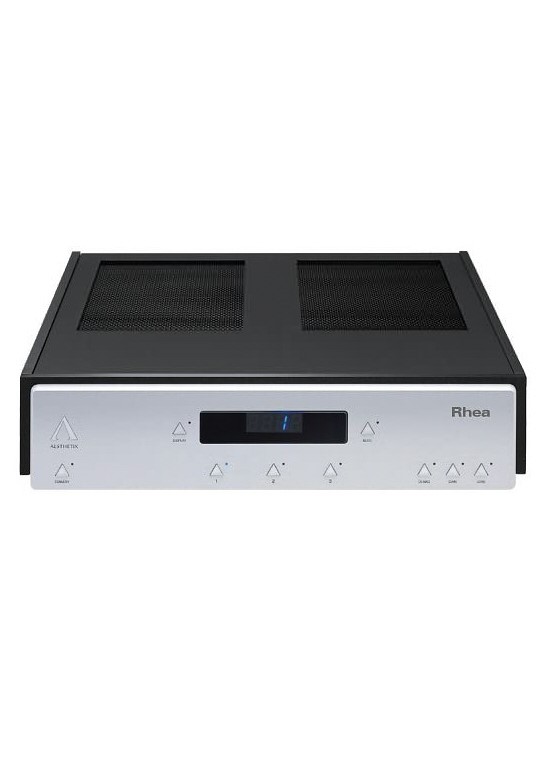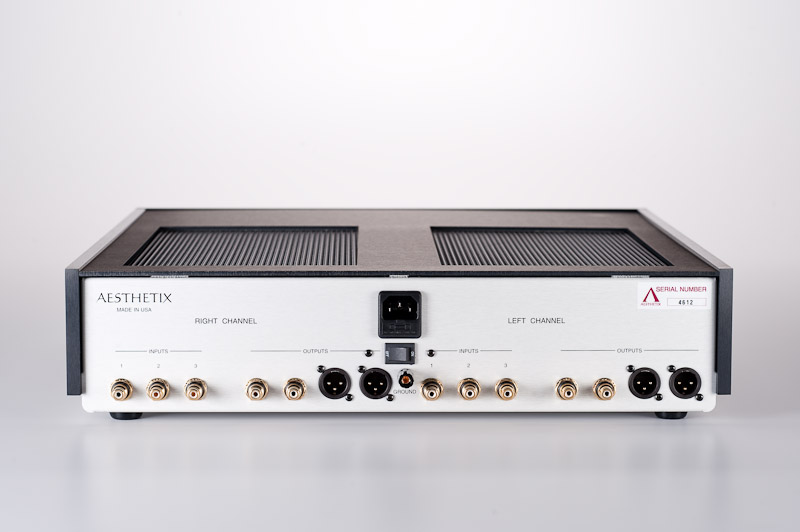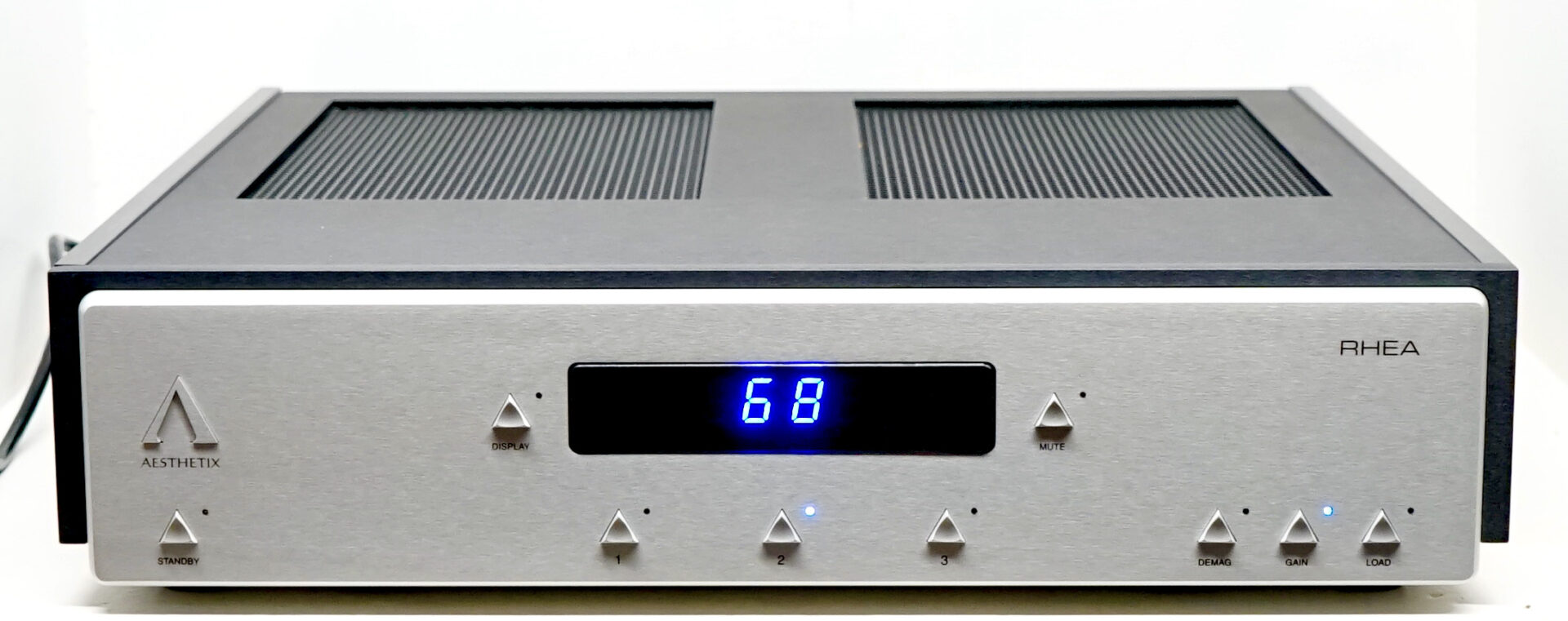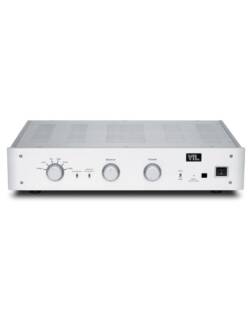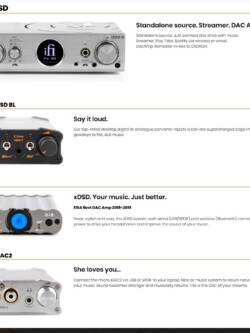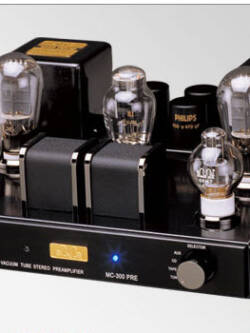Aesthetix Rhea Signature Phonostage
Original price was: R193,000.00.R88,000.00Current price is: R88,000.00.
Aesthetix Rhea Signature Phonostage

It has long been an article of faith among audio “objectivists” that passive components—wire, resistors, capacitors, and inductors—have no effect on the sound of the product in which those components are used. That is, two capacitors of the same value will perform identically in the circuit—so why not use the cheapest version possible? This thinking led to some audio products, including professional gear, that were loaded with cheap carbon resistors, internal “hook-up” wire, and electrolytic coupling capacitors. Anything more was deemed a waste of money.
The high-end takes a different view. The designer of a well-regarded D-A converter told me about how, before going into production with his latest product, out of curiosity he replaced a $1 resistor with a $10 resistor (in the current-to-voltage converter’s feedback loop). The difference in sound was so great that he couldn’t imagine shipping the unit with the $1 resistor. The company absorbed the price difference.
So how much difference do exotic parts make in the sound of an audio product?
The Rhea Signature phonostage from Aesthetix provides a fascinating test bed. The Signature version uses the same circuit as the standard unit, but in the Signature that circuit is implemented with the higher-quality parts found in the $15k Aesthetix Io phonostage, making it possible to evaluate the sonic difference between very good and nearly-cost-no-object passive components. The price difference is substantial; the Rhea is $4000 and the Rhea Signature $7000. Rhea owners can upgrade to the Signature for the $3000 difference.
I know the standard Rhea very well; it’s been my phonostage of choice since I reviewed it in Issue 151 (December, 2005). The new unit looks nearly identical on the front and back—only a subtle “Signature” legend is etched on the display’s glass. But one peek under the hood and you can see that this is a different product. For example, the Rhea uses very high-quality Rel-Caps at many points in the circuit, but the Signature replaces these with huge red polypropylene film-and-foil caps from Dynamicap. In addition to such upgrades in parts quality, the Signature employs noise damping inside the chassis, as well as special vibration-absorbing feet under the transformers, choke, and the first gain stage (a point at which keeping noise low is critical). These feet are made by Harmonic Resolution Systems, the company that makes perhaps the most elaborate, best-engineered, and most beautiful equipment racks in the industry. The Signature’s tubes are selected to a higher standard—only 10% of the tested tubes pass muster. Finally, the Signature employs expensive variable capacitors in the RIAA equalization circuit to enable hand-tuning of the network for perfectly flat frequency response.
I had the Rhea and Rhea Signature side-by-side in my rack, driven by the outstanding Basis 2800 Signature turntable (fully loaded with Calibrator Base, Syncho-Wave power supply, vacuum hold-down, and Micro-Thin belt), Basis Vector 4 tonearm, and either a Dynavector XV-1s or Air Tight PC-1 Supreme cartridge. (Incidentally, the PC-1 Supreme was a complete revelation to me; I’d never heard a phono cartridge that was simultaneously so resolving yet so smooth and relaxed. The classic trade-off in cartridges between detail and musicality was rendered moot by the PC-1 Supreme.)
Being so familiar with the Rhea, it didn’t take long to appreciate the difference in the Signature. The biggest surprise was the bass, which exhibited far greater weight, extension in the lowermost octave, and dynamic impact. This wasn’t a subtle difference, but rather a wholesale transformation of the bottom end. Kick drum had more impact and solidity, and bass guitar was fuller in timbre and more fully fleshed out in body. The difference in the low end was fully equal to that of changing cartridges—or even loudspeakers. It was nearly on the level of moving from a stand-mount loudspeaker to a small floorstanding unit.
It wasn’t just that the Signature had more bass; it also had better bass. Small-scale dynamics, pitch articulation, and richness and density of tone colors were all in a different league. The Signature had a sense of tautness, precision, and detail that made the standard Rhea sound a bit soft, muddled, and smeared by comparison. Just listen to Jaco’s fabulous ensemble playing (and solo) on the Wayne Shorter composition “Port of Entry” from Weather Report’s Night Passage—the Signature revealed a new level of intensity and virtuosity in Jaco’s performance. After switching to the Signature, this live track was electrifying and thrilling in a way I hadn’t experienced before. The Signature resolved the blinding speed, the precise articulation of each note (in both pitch and dynamics), and the sheer musical intensity of the performance. The standard Rhea sounded a bit “watered down” by comparison, with less of the vibrant energy that makes this track special.
Without making a conscious effort, I found myself focusing on and appreciating the rhythmic contribution of bass players. I’ve heard the wonderful Bill Evans album Quintessence countless times, but through the Signature discovered another level of artistry in Ray Brown’s nuanced performance. Through his dynamic inflections, Brown creates his own varying rhythmic flow within the relatively stable time established by drummer Philly Jo Jones. Brown makes intriguing excursions that add a playful bounce to the sparse arrangements, notable on “Sweet Dulcinea.” The Signature’s greatly improved bass gave me a deeper involvement in, and appreciation for, this old favorite.
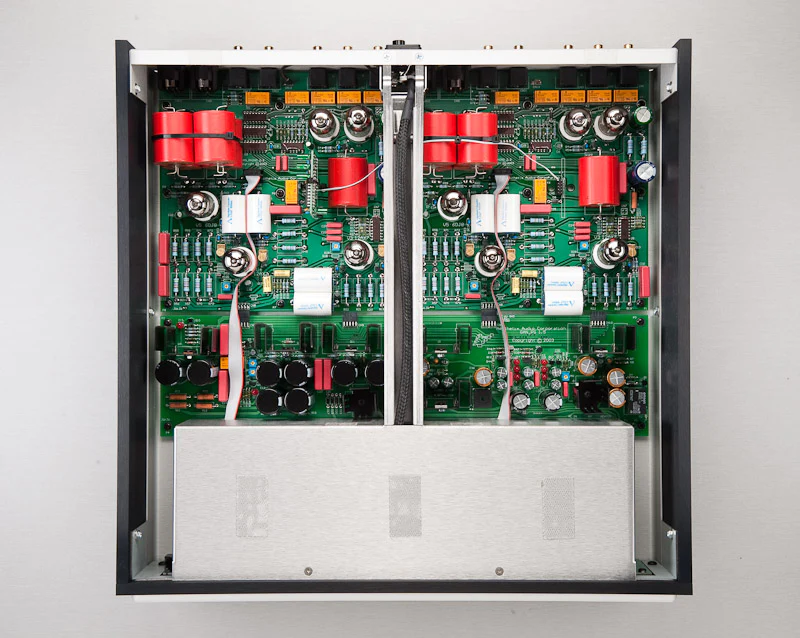
In the bass octaves audio components often make a trade-off between weight and precision. The leaner-sounding products tend to better reveal detail and dynamics; the warmer-sounding components are often a little smeared and slow. The Signature’s central triumph is its combination of raw bass power and heft coupled with speed, precision, and articulation. It was a combination I found addictive—particularly with the spectacular bass qualities of the Air Tight PC-1 Supreme cartridge.
Another dramatic improvement of the Signature was its cleaner, sweeter, and more refined treble. The top end had much more detail and nuance. For example, the Signature resolved the fine inner detail of cymbals in a way that the standard Rhea couldn’t match. The stick hitting the metal, the fine complex shimmer, and the way the decay of the instrument hung in the air were significantly better resolved by the Signature. Moreover, treble textures were smoother, purer, and less grainy through the Signature. Solo violin, the string sections of chamber ensembles, and massed orchestral strings all sounded more “organic” through the Signature thanks to its greater refinement, resolution, and reduction in grain. Although the standard Rhea is a great phonostage, the Signature makes it sound a bit coarse and grainy.
This combination of greater resolution and a more natural rendering of timbre extended to the midrange, but not to the same degree I heard in the treble. In the mids, instrumental texture was richer, denser in tone color, and more immediate. Despite the greater sense of palpability in the midrange, the overall perspective through the Signature was slightly more distant than through the standard Rhea. The Signature moved the soundstage back just a bit, and better resolved layers of depth. Having said this, however, I thought that the Signature made certain instruments seem to jump out of the soundstage with greater immediacy. Percussion and other instruments with steep transients seemed to suddenly appear right up front in the soundstage—the timbales on the terrific Mobile Fidelity reissue of Santana’s Abraxas, for example. Not only were depth and presence markedly improved, so was the resolution of instrumental decay.
You should know that if you value a dead-silent background, the Rhea and Rhea Signature might not be for you. This phonostage has up to a whopping 75dB of all-tube gain, which makes for some background noise in some systems. Many tubed phonostages employ a low-noise solid-state gain stage at the input (usually an FET) to amplify the cartridge’s output to a level that requires far less gain from the tubes. Others rely on a step-up transformer for the same reason. The Rhea is pure tube from input to output, with all the advantages and drawbacks of that topology. In addition, the noise level is highly dependent on tube quality.
Conclusion
I was really quite shocked by how much better the Rhea Signature sounded than the standard Rhea. In fact, I had planned on many long sessions of going back and forth between the two products to discern and describe the differences, but quickly realized that was unnecessary. Moreover, I enjoyed music so much through the Signature that it was hard to go back to the standard Rhea.
As great a phonostage as the Rhea is, the Signature version is on another level of performance. Yes, it’s nearly twice the price ($4000 vs. $7000), but the Signature is that much better. If you already own the Rhea, upgrading to the Signature will give you a new perspective on your record collection and favorite music. It did for me.
__________
Inside the Rhea
The standard and Signature versions of the Rhea share the same features and circuit topology. Both are slightly simplified versions of Aesthetix’s acclaimed Io phonostage. The unit features unbalanced inputs, with balanced inputs available for a small additional charge. The gain is adjustable in eight steps, with up to 75dB of gain at the maximum setting. Nine different cartridge loadings are provided. The gain and loading can be set independently for each channel. The way in which you adjust the gain and loading is very cool: Press the “Gain” button, for example, and the amount of gain in dB appears on the front-panel display. Simply push the right side of the display to increase the gain, or the left side to decrease it. The arrangement is the same for changing cartridge loading. In addition, you can adjust gain and loading from your listening seat via the supplied remote control.
The circuit is based on five tubes per channel, with two 12AX7LP tubes at the input operated in single-ended mode followed by a single 12AX7WB that functions as a phase splitter to create a balanced signal. The output of the 12AX7WB is filtered by a passive RIAA network, and then amplified by another 12AX7WB. The output buffer is a 6DJ8. Unique to the Signature version are variable capacitors in the passive RIAA network that allow each unit to be hand-calibrated for flat RIAA response. The variable gain and loading are realized with two separate switched-resistor networks.
The power supply is huge, and features all-discrete regulation (except for the supplies of the control and display circuits). The power transformers are mounted on an isolated substrate and encased in shielding.
The metalwork, industrial design, interior layout, and build-quality are exemplary. Moreover, the feature set—three inputs, adjustable gain and loading via remote control, built-in cartridge demagnetizer, balanced outputs—makes the Rhea compatible with a wide range of systems. RH
Aesthetix Rhea and Rhea Signature Phono Stages
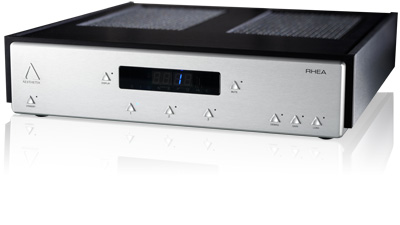 Since its inception, in 1993, Aesthetix Audio Corporation has been known for its tubed phono stages. Specifically, the all-tubed Jupiter Io (named for the innermost of that planet’s moons) has made a claim as the phono-stage champion for over 15 years, especially in its most extreme version, the Total Eclipse with dual power supply ($6500-$23,000 USD, depending on configuration). The Io’s little brother, the Saturn Rhea, joined the fray in 2002, offering single-box elegance and operational efficiencies. Initially hailed as an affordable giant-killer, the standard Rhea ($4000) was recently joined by a hot-rodded variant, the Rhea Signature ($7000). (Rhea, Saturn’s largest airless moon, is named for “the mother of the gods” of ancient Greek mythology.) With two Rheas now orbiting Saturn, a few questions arise. Has the standard Rhea held its own over the past seven years? Do the performance gains of the Signature justify the increased scratch? Like an astronomer, I felt compelled to seek answers from the heavens.
Since its inception, in 1993, Aesthetix Audio Corporation has been known for its tubed phono stages. Specifically, the all-tubed Jupiter Io (named for the innermost of that planet’s moons) has made a claim as the phono-stage champion for over 15 years, especially in its most extreme version, the Total Eclipse with dual power supply ($6500-$23,000 USD, depending on configuration). The Io’s little brother, the Saturn Rhea, joined the fray in 2002, offering single-box elegance and operational efficiencies. Initially hailed as an affordable giant-killer, the standard Rhea ($4000) was recently joined by a hot-rodded variant, the Rhea Signature ($7000). (Rhea, Saturn’s largest airless moon, is named for “the mother of the gods” of ancient Greek mythology.) With two Rheas now orbiting Saturn, a few questions arise. Has the standard Rhea held its own over the past seven years? Do the performance gains of the Signature justify the increased scratch? Like an astronomer, I felt compelled to seek answers from the heavens.
It’s hip to be square
To protect the Rhea from even the most haphazard of delivery personnel, it arrives sheathed in thick poly wrap and nestled between the upper and lower halves of a closed-cell foam encapsulation. Its ten tubes are individually packed in numbered boxes, themselves constrained in bubble-wrap in two groups of five (one set each for the left and right channels). The top cover is secured by a hook-and-loop fastener (think Velcro) exploited by several high-end companies for its antiresonant qualities, and is easy to remove and reattach. The manual is not only well written and complete, but a diagram and step-by-step instructions make tube insertion a snap. Inserting those tubes, I saw the true beauty of the layout of the Rhea’s dual-mono design. The interior’s discrete and identical left and right channels are separated by a stainless-steel channel that shields the AC wires from the sensitive audio circuitry as they travel from the enclosed rear receptacle to the voltage transformer of the choke-input power-supply. But once the tubes had been inserted and the interior admired, it was time to replace the cover and settle the Rhea into the equipment rack.
The standard Rhea is a full-sized component that shares the same chassis as its Saturn-series stablemates, the Calypso line stage and the Janus full-featured preamplifier. It weighs more than 30 pounds and, at 18″W x 4 3/8H x 17 5/8″D, is nearly square — it used up most of the depth of my rack. The black, brushed, and anodized aluminum of the chassis and side panels is complemented by a front panel available in silver or black. Very elegant. The pushbuttons, each a reproduction of the Aesthetix logo, hint at the Rhea’s expansive feature set.
Flexibility is a key theme. Enabling a setup comprising multiple turntables and/or tonearms are three separate single-ended (RCA) inputs, each of which can be set for a different gain and loading. Eight gain settings from 38 to 75dB are selectable, along with nine different load options ranging from 75 ohms to 47k ohms. The front-panel buttons for Input, Mute, Gain, Loading, Demagnetization, and Standby are duplicated on the remote control, making cartridge optimization from the listening position more than just a convenience. Each channel has two sets of XLR and two sets of RCA outputs. A heavy-gauge IEC power cord is included, but owners are free to use their preferred audiophile-approved AC cord. Also included is a built-in moving-coil demagnetizer — a nice touch, and unique in my experience.
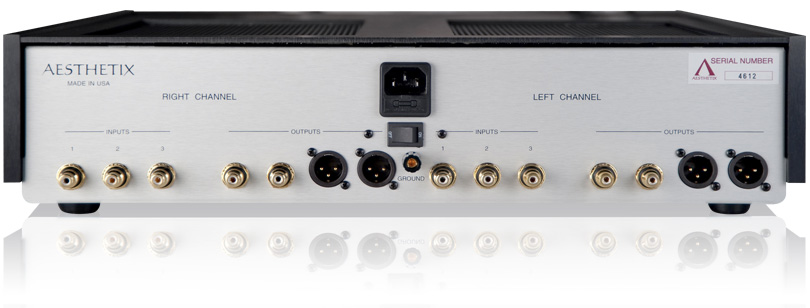
System
I auditioned the Rhea exclusively in my main rig: Vandersteen 5A loudspeakers, Ayre Acoustics KX-R line-stage preamplifier, Ayre MX-R monoblock power amplifiers, and a VPI Industries Scout turntable with a Benz Micro L2 cartridge feeding the Rhea or my reference Ayre P5-xe solid-state phono preamp. Wiring consisted of Ayre Signature interconnects and externally biwired speaker cables, along with Cardas Golden Reference AC cords and Ayre L-5xe passive power conditioners. The MX-R monoblocks, sitting atop custom Harmonic Resolution Systems M3 platforms, reside next to the speakers to minimize the speaker-cable length to 1m. All my other equipment is supported by a custom Billy Bags rack, the turntable resting on another HRS M3 platform.
A toe-tapping extravaganza
It didn’t take long to warm to the Aesthetix Rhea. With familiar LPs playing and remote control in hand, I quickly dialed in my Benz Micro cartridge to perfection (2500 ohms loading and 56dB of gain worked best). Although Aesthetix cautions against forming any conclusions until at least 100 hours of break-in have elapsed, the Rhea made a compelling case for itself straight away. I couldn’t help but have a smile on my face and a swing in my step as I pulled record after record from the shelf. There was such an infectious, musical joy at work in the Rhea that I logged those first 100 hours in mere weeks.
Yearning for some bluegrass fun, I fired up So Long So Wrong, by Alison Krauss and Union Station (Rounder/Mobile Fidelity Sound Lab MFSL 2-276). The high-speed duel between banjo and mandolin in “Little Liza Jane” had my heart racing and my toes tapping. The Rhea kept up with the frenetic fretwork; its sorting of out the dynamic interplay of the distinct instruments made it clear why “Little Liza Jane” won the 1998 Grammy for Best Country Instrumental Performance.
For a more visceral test, I turned to the title track of Metallica’s Master of Puppets (Warner Bros. 470908-1). Between Cliff Burton’s bass and Lars Ulrich’s percussion, this track — often cited as the greatest heavy-metal song of all time — is a torture test for any system, but the Rhea was not fazed. Certainly the 45rpm, 180gm treatment Warner Bros. has lavished on this album deserves some of the credit, but I found myself cueing up the song three times in a row.
From the fast and the furious, my listening sessions took a more contemplative turn, with Frank Sinatra’s Only the Lonely (Capitol/Mobile Fidelity Sound Lab MFSL 1-326) then hitting the VPI ’table. The melancholy was so palpable that by the end of the album’s final song, “One for My Baby (And One More for the Road),” I felt I needed a drink. The Rhea showed not only what a great album and a great pressing this edition of Only the Lonely is, but also highlighted the singularity of Sinatra’s timing, voice, and expressiveness.
During the several weeks the Rhea was out of my system being upgraded to Rhea Signature status, I had time to reflect on comparisons with my Ayre P-5xe, itself a tremendous performer and a bargain at only $2500. Being a solid-state component, the Ayre requires zero attention — it’s simply “on” and ready to go at all times. By contrast, the Aesthetix manual recommends placing the Rhea in Standby mode whenever it’s not in active use, instructions I followed to a T. In Standby, the Rhea powers everything but the tubes themselves, which keeps startup time to a mere 30 seconds. Nevertheless, this extra step is a slight inconvenience, and a reminder that operational differences between tubed and solid-state gear are genuine.
Also, the basic Rhea lacks the Ayre P-5xe’s jet-black noise floor. Although never an issue while music was playing, the noise floor was noticeable in the silences between tracks, sides, and albums. Nor did the Rhea possess the Ayre’s unflappable neutrality throughout the audioband. That’s not to say the Rhea was adding those euphonic colorations usually attributed to tubes. Rather, it seemed to introduce a slow rolloff in the top octave or two — certainly expected, with its cascade of four all-tube gain stages — while the lowest bass, although authoritative, took on a very slight bloom. Those quibbles aside, the fact remained that, during its absence, I truly missed the Rhea’s palpable musicality and ability to engage me. The countdown to the arrival of the Rhea Signature was excruciating.
What’s in a Signature?
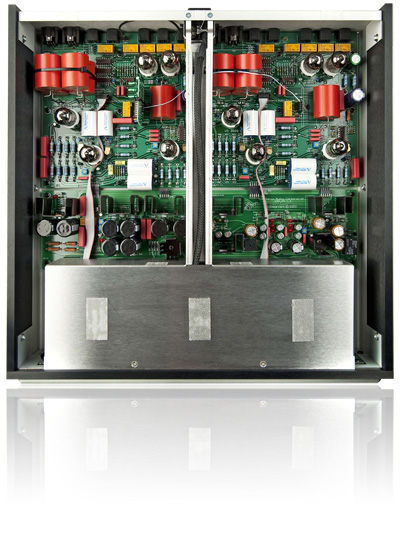 At $7000, the Signature is almost twice the price of the basic Rhea, but the only external differences are a set of custom HRS Nimbus Couplers replacing the stock feet on the chassis’s bottom, and a subtly stenciled “Signature” on the lens of the display. The HRS devices are certainly effective at damping the chassis, but their high-grip design — almost like suction cups — require that you be prepared to lower rather than slide the Signature into position on its shelf.
At $7000, the Signature is almost twice the price of the basic Rhea, but the only external differences are a set of custom HRS Nimbus Couplers replacing the stock feet on the chassis’s bottom, and a subtly stenciled “Signature” on the lens of the display. The HRS devices are certainly effective at damping the chassis, but their high-grip design — almost like suction cups — require that you be prepared to lower rather than slide the Signature into position on its shelf.
But the Signature is one book you can’t judge by its cover. Inside, the differences from the standard Rhea are legion — designer Jim White simply couldn’t let the mod shops have all the fun with his baby. The 2uF coupling capacitor between the first and second gain stages of each channel is traded for a 4uF Dynamicap by Peter Moncrief, while custom interstage hybrid coupling capacitors of Teflon replace the polypropylene units between the second and third and the third and fourth gain stages, for a total of four per channel (given the balanced nature of the circuitry from the second gain stage onward). Similarly, four 4uF Dynamicaps per channel replace the 2uF output coupling capacitors. Unlike the standard caps, which look like M-80s, the new capacitors resemble bundles of miniature oilcans. Furthermore, highly specialized, adjustable air-core capacitors (primarily employed in the radio-frequency realm) are installed and adjusted to fine-tune the circuit, calibrating each channel to a rigid standard (and to each other) to optimize the high-frequency response under the RIAA curve. According to Aesthetix, the collective effects of these superior parts are, primarily, increases in resolution and dynamics and a reduction in grain. But seeing where the extra money was spent is one thing; hearing its effects is another.
The black is back
Immediately following power-up, and before I’d dropped the needle on the first record, the Rhea Signature showed its hand with a jet-black background every bit as quiet as the Ayre P-5xe’s. In fact, I did a double-take to confirm that I hadn’t inadvertently activated the Mute button — I hadn’t. This was undoubtedly the cumulative effect of the HRS couplers, the upgraded capacitors, and the Signature’s ability to be dialed in, and I was confident that this first observation was a harbinger of things to come.
I revisited Master of Puppets to test whether the Signature could pull the strings of this metal masterpiece’s rhythm, pace, and drive. The increase in low-end control was complete. The interweaving of complex lines cut through the maelstrom just as does James Hetfield’s barked chorus of “Master, master.” Returning to Sinatra’s passages of lament, I felt as if I were that lonely guy shrouded by cigarette smoke, downing yet another cocktail to dull the pain of heartbreak.
As the records spun, a clear increase in resolution and dynamic/microdynamic cues unfolded, this time with no identifiable grain or noise to obscure or distract. The Rhea Signature built on the strengths of its namesake while minimizing or even eliminating the few compromises evident in the original. Without any remaining evidence of deviation from neutrality, the Signature’s suitability as a reviewer’s tool was obvious during the nuanced leadership of John Coltrane on “All or Nothing At All,” from Ballads (Impulse!/ORG ORG 012). A certain solitude lurked beneath the notes as the melody was captured and conveyed with aplomb.
Thankfully, the fun quotient and emotional force evident in the sound of the standard Rhea was not diminished but enhanced in the Signature. The conveyance of the intimate, personal, raw, often angry emotions of Liz Phair was manifest throughout her uncompromising debut album, Exile in Guyville (ATO 21627). A deft mix of the excitement of independence and the malaise, disillusionment, resentment, and uncertainty of youth, this album has been a favorite of mine since its release in 1993 — but its 15th-anniversary reissue on 180gm vinyl made me want to toss my well-worn CD original.
Objectively, the standard hi-fi qualities of soundstage, timbre, and timing were all present, as were resolution, drive, and continuousness. Yet to focus on these individual attributes is to miss the point of the Rhea Signature — a component that demands a holistic realization of music reproduction. A perfect example of the Signature’s ability to convey the engrossing nature of the sublime was evident when I spun Sonny Rollins’ Way Out West (OJC/Stereo Records S7017). Never before had I been so vividly transported to the dusty streets of the Old West when listening to “I’m an Old Cow Hand.”
The differences among the Ayre P-5xe, the Rhea, and the Rhea Signature may best be explained via a film analogy. Music through the P-5xe is akin to watching a digital projection of a movie: everything is technically correct and razor-sharp, and the 100th showing is exactly the same as the first. Listening through the standard Rhea was like watching a 35mm print on opening night: there might have been a bit of film grain, but the organic, continuous nature of the film could be more engrossing. The Rhea Signature was more like a 70mm “show print” projected on a CinemaScope screen: film grain was eliminated, the depth of information was increased, and the viewing experience was enveloping. Perhaps the Io Total Eclipse would be the equivalent of an IMAX showing.
Planets, moons, and poetry
Contemplating the nature of the Aesthetix Rhea, and especially that of the Rhea Signature, led me to revisit a passage from Daniel Dreiberg’s essay “Blood from the Shoulder of Pallas,” the following partial adaptation of which captures the essence of my conclusions (the essay was actually written by Alan Moore, who attributes it to Dreiberg, aka Night Owl, as the same appears at the end of chapter VII of Moore’s Watchmen):
Is it possible, I wonder, to study a component so closely, to observe and catalogue its peculiarities in such minute detail, that an understanding of its true character evaporates? Is it possible that while fastidiously scrutinizing its harmonic distortions or the depth of its soundstage, we somehow lose sight of its poetry? That in our pedestrian descriptions of a polished or anodized visage, we forfeit a glimpse of living canvases, cascades of carefully toned allegros and andantes that would shame Monk, misty explosions of symphonic color to rival Beethoven? I believe that we do. I believe that in approaching our subject with the sensibilities of statisticians and dissectionists, we distance ourselves increasingly from the marvelous and spell-binding planet of imagination whose gravity drew us to our explorations in the first place.
This is not to say that we should cease to establish facts and to verify our information, but merely to suggest that unless those facts can be imbued with the flash of poetic insight, then they remain dull gems; semiprecious stones scarcely worth the collecting.
Ultimately, the essence of the Rheas proved to be their ability to capture the gestalt of the music being played — a communication of the wholeness of the performance with its emotional impact intact. These phono stages are more than just the sums of their parts, more than their features and flexibility, more than the soundstages they throw, their grip on timing, their illumination of individual players and instruments and the spaces between them.
The standard Rhea deserves the accolades it has received over the years, and continues to prove a value leader at $4000. That it now marks the beginning of an upgrade path makes it a fantastic musical investment. Which takes us to the Rhea Signature, shining brighter than Saturn itself on a clear night. The Rhea Signature has elevated my system’s ability to transfix and transport me, and is well worth the $3000 surcharge, if you can swing it. I have no need to consult an astrologer to know the future. It is here: The Rhea Signature has become my reference system’s new phono preamplifier.
The Rhea’s bass performance was firmly cohesive by any standard. The spatial and tonal bloom of tubes was neatly combined with resolute pitch definition. Each bassist’s individual sound and personality were preserved with distinctiveness and particularity, be it Paul Chambers or Jaco Pastorius. Things were just a fraction more loose down low than with the Io Sig or the Steelhead, but there was no shortage of power or pitch certainty.
The Rhea was a shade softer and darker than life in the top half-octave or so of the treble range, perhaps, but there was still more than enough resolution to describe the shape and size of recording venues. Far better to have a smidgen of mellowness here than an overly aggressive and artificially transparent etched sound. This bit of forgivingness did nothing to impair the tonal brilliance of Jascha Heifetz’s violin in Beethoven’s Violin Concerto (Munch/Boston, RCA Living Stereo/Classic LSC-1992). The master’s fiddle was crisply defined, with outstanding delineation of bowing and a scintillating clarity during the cadenza, and no blurring or obscuring of his dazzling technique.
Soundstaging was invariably very good, with an estimable sense of depth, width, and height. On the Beethoven concerto, the spacious acoustic of Boston’s Symphony Hall filled the back of my room, though the Manley Steelhead and the Io Signature illuminate the rearmost corners of the stage a pinch more evenly and completely. With rock and pop LPs, the material, not the Rhea, set the size of the stage—as it should—and small-group jazz LPs had a pleasing sense of immediacy and involvement, that gratifying sense of eavesdropping on a performance rather than listening to a recording.
“Musical flow” is a quality that is drawing increasing attention in the hi-fi press. To my mind, “flow” requires three primary things: first, well-controlled bass that is capable of going down deep without losing definition, in order to firmly establish the music’s rhythmic pulse; second, a continuousness and general neutrality of timbre throughout the audible range, so as to maximize the individual character of each instrument and voice; and, third, a high degree of spatial resolution.
“Animal Waves,” from Can’s Saw Delight (UK Virgin V 2079), is 15 minutes of scrumptious and intense musical sensuality that demands “flow” to communicate its heady, almost erotic, essence. Pulsing Afro-Caribbean rhythms ground spaced-out washes of keyboards, and electric violin and guitar converse with both the cosmic and the carnal. The earthy throb of bass guitar, drums, and the complex syncopations of Reebop Kwaaku Baah’s percussion was taut and composed, while the swoops and whooshes of Irmin Schmidt’s electronic keyboards waxed and waned like a celestial tide. This was flow with a vengeance.
A Quart in a Pint Pot
Judged by the high standards Jim White set for himself in designing it or considered strictly on its own merits, the Aesthetix Rhea is a runaway success. Nope, it doesn’t have quite the Krakatoan dynamic range of the Io Signature, quite the sheer speed and resolution of the Manley Steelhead, or quite the massive technological overkill of the Boulder 2008—and none of that matters a bit or a smidgen. To get the last little bit of those things, you’ll spend from nearly double to eight times the Rhea’s $4000 cost. The Rhea’s most remarkable accomplishment is to put together an extraordinary combination of sonic performance and useful features at a price that is within reach for many serious vinyl addicts.
The Rhea tells a striking amount of musical and sonic truth and is, in terms of sound alone, intensely lovable. Did I notice the difference when the Steelhead or Io Signature went back in the system? Sure. But the Rhea has enough of all the qualities that make the megabucks competition so special to make it a source of constant musical joy. Not once did I feel that the Rhea shortchanged any LP I heard through it. That, together with the too-cool-for-school remote functions, multiple inputs, built-in cartridge demagnetizer (for those of that persuasion), and first-class presentation, make it worthy of a wildly enthusiastic recommendation. This one, cats and kittens, is killer good.
Michael Fremer wrote about the Rhea in June 2005 (Vol.28 No.6):
The Aesthetix Rhea tubed phono stage ($4000, reviewed by Paul Bolin in the September 2003 Stereophile), which I have in-house in association with a forthcoming review of the companion Aesthetix Calypso preamp, offers three independent inputs, remote-controlled loading and gain on the fly, and automatic MC demagnetization. The Musical Fidelity kW phono preamp ($3500) can’t begin to compete with the Rhea’s versatility and ease of use, nor does its midrange offer the Rhea’s lushness and soft finish. The Rhea can’t begin to match the kW’s bass extension and grip, or (especially) its taut control and seemingly infinite dynamic contrasts. While the Rhea is exceptionally quiet for a tube preamp, especially one that offers so much gain without a step-up transformer or transistor in the signal path, the kW’s black hole of background darkness yielded unsurpassed degrees of detail of low-level dynamics and resolution.
But the Rhea’s sound is far more cozy, rich, and silky. While, like CD sound, the kW may be more technically accurate, it will leave many listeners—especially some classical music lovers—a bit chilled. Its transient delivery could sometimes edge toward harshness, and its harmonic development seemed to stop at the water’s edge compared to a tubed design.
I’ve just been sent two new, superbly recorded direct-to-disc LPs from Analogue Productions Originals. I’ve played one, bluesman Leroy Jodie Pierson’s D2D (no catalog number), through the Musical Fidelity kW, the Aesthetix Rhea (run at 47k ohms to make the comparison fair), and the revised Ayre P-5x ($2395) phono sections. While both the tubed Rhea and the FET-based Ayre put the closely miked bluesman in a barely discernible space (Blue Heaven Studios), the kW seemed less concerned with the space and more interested in the main event. Although one’s tubed and one’s solid-state, both the Rhea and the P-5x had creamier midbands than the kW. But neither could match the kW’s bottom-octave and dynamic presentation—it wasn’t even close.
The superbly designed and built Aesthetix Rhea—with its three independent inputs, remote-controlled loading and gain, auto demagnetization, and quiet, silky smooth, ultrarich sound—represents one of the best values in phono preamps now available. It, too, is a pick for Class A, though its personality is very different from the kW’s.—Michael Fremer
Description
SPECS&PRICING
Aesthetix Rhea Signature phonostage
Tube complement: Two AX127LP, two AX7WB, one 6DJ8 (per channel)
Inputs: Three RCA
Outputs: Three RCA, two XLR
Features: Front-panel-variable gain and loading (independent for each input); remote-control gain, loading, and cartridge demagnetizing
Dimensions: 18″ x 4.4” x 17.6″
Weight: 40 lbs. (shipping)
Price: $7000
Aesthetix Rhea Signature Phono Stage
Rhea Signature is an all-tube phono stage, suitable for moving coil and moving magnet cartridges. It offers high maximum gain at 75 dB, making it ideal for low output cartridges. Rhea broke new ground as the first phono stage with 3 phono inputs, the first with gain and loading settings stored in memory for every input, and the first with full remote control adjustability. Dual-mono audio boards provide superb channel separation and soundstaging. A cartridge demagnetizer is a built-in convenience that can also be operated by remote control. The all-aluminum chassis is designed for rigidity and acoustic inertness, the brushed anodized panels are beautiful too. Rhea has enjoyed worldwide acclaim for its sound quality, build quality, flexibility and ease of use.
• Three RCA inputs.
• Each input has its own gain and loading setting that is saved even when in standby mode or the unit is turned off.
• Zero feedback.
• 40-75dB gain maximum, selectable via front panel or remote control.
• 9 MC loading settings: 75-47,000 ohms, selectable via front panel or remote control.
• Remote control of gain, loading, input switching, mute, and demagnetizer.
• Built-in MC cartridge demagnetizer.
• Two sets of XLR and two sets of RCA outputs per channel.
• All tube amplification and output (10 tubes total).
• Full function remote included.
• Available in black or silver faceplate.
Rhea is available in two versions: Standard and Signature. The Signature version uses exotic and expensive coupling capacitors and other critical parts to bring the performance to a higher level.
The Signature version uses custom-made inter-stage Teflon hybrid coupling capacitors, replacing the polypropylene units, between the 2nd and 3rd, and 3rd and 4th, gain stages (4 total per channel). The change in these capacitors results in higher resolution, extension, less grain and more air. The 2uF coupling capacitor between the 1st and 2nd gain stages is replaced with a 4uF Dynamicap by Peter Moncrief (1 per channel). This change removes grain and provides more openness, while also increasing bass dynamics and slam. The 2uF output coupling capacitors (4 per channel) are also replaced with 4uF Dynamicaps. This change provides more drive, bass extension, resolution and dynamics while also reducing grain. Highly specialized adjustable air-core capacitors, used primarily in the radio-frequency realm, are installed and adjusted to “tweek” each unit to a rigid standard. The five rubber feet are replaced with Harmonic Resolutions Systems’ Nimbus Couplers specially made for Aesthetix (Earlier Signature Saturn pieces did not incorporate this, please contact Aesthetix for this free upgrade if you have an earlier Signature piece without the Nimbus Couplers). This change results in a lower noise floor and more air and space. The cost of these specialized parts alone is about 1/4 the manufacturing cost of a brand new unit! Any tubes that can be bettered by our special stock of graded and matched tubes are replaced. Any other improvements needed to make the unit current are installed, including software updates, etc. A new lens with “SIGNATURE” stenciled is installed. Each Signature unit undergoes rigorous test procedures and listening.
Specifications
Inputs: 3 discrete phono inputs with RCA (SE)
Gain settings (selectable for each input): 8 total; 75, 68, 62, 56, 50, 44, 38 dB, and off
Load settings (selectable for each input): 9 total: 47 K ohms, 10K, 5K, 2.5K, 1K, 500 ohms, 250, 125, and 75 ohms
Outputs: 2 RCA (SE) and 2 XLR (balanced)
Output impedence: 1K ohms RCA (SE), 600 ohms XLR (balanced)
Front panel controls: phono input, mute, gain, loading, demagnetizer, and standby
Remote controls: phono input, mute, gain, loading, demagnetizer, and standby
Frequency response: +- 0.25 dB, 20 Hz – 20 KHz
Signal to noise: measured at 70 dB minimum A-weighted (ref 1 mv input, 75 dB gain setting)
Recommended load: 10 k ohms or greater
Tubes (each channel): V1 & V2 (12AX7LP-factory graded low noise), V3 & V4 (12AX7 or equivalent) and V5 (6922)
Power consumption: 20 watts standby, 100 watts active
